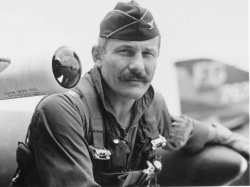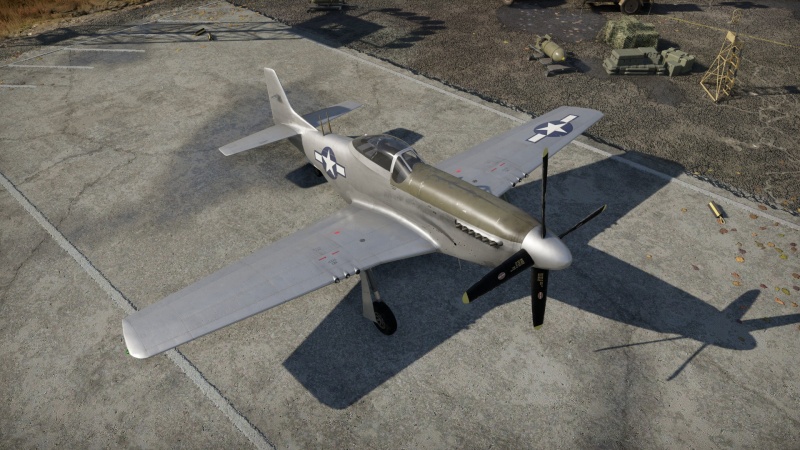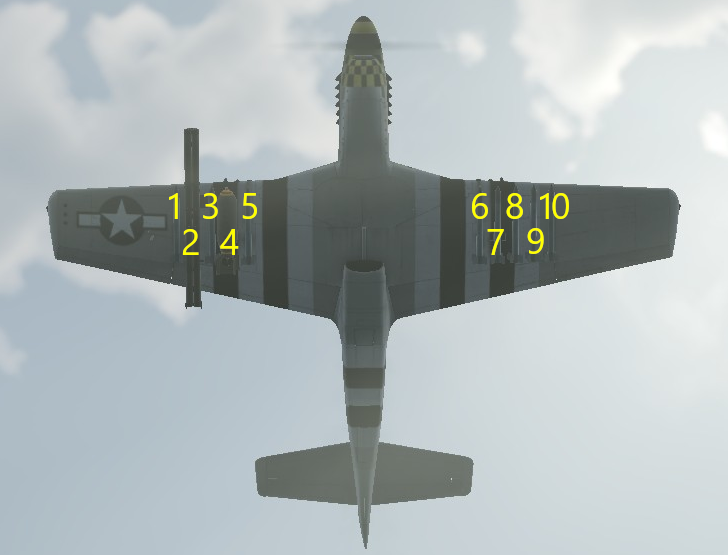P-51D-20-NA
| This page is about the gift American fighter P-51D-20-NA. For other versions, see P-51 (Family). |
Contents
Description
The P-51D-20-NA Mustang is one of the many variants of the Mustang produced by North American. The P-51D variant was the most produced variant of the Mustang family featuring improved wings and was built at multiple locations. The "-NA" denotes that the aircraft was built at North American's Inglewood plant. "-NT" aircraft were built at North American's new plant in Texas. Around 1,600 D-20s were built at Inglewood meanwhile 400 were built in Texas. The D-20 series of aircraft were built with the K-14 gunsight which was the USAAF name for the Mark II gunsight. The D-20 lacked the higher manifold pressure of the D-30 variant and more closely resembles the D-5.
Introduced in Update 1.33 as a premium pack, the P-51D-20-NA Mustang is a decent aircraft but has some flaws. The D-20 is very close to the D-5 in performance and shares the lower manifold pressure (lower power). However, it does have an improved rudder design which helps with controllability at higher speeds. The D-20 also has access to late-war .50 cal belts which feature the extremely dangerous tracer belt with full API-T composition. Like many P-51s, the D-20 also has bombs and two different types of rockets. Although the P-51D-20-NA Mustang is fast, it suffers in climb rate and is limited in its capabilities due to the lower engine power. Players must stick to the P-51s advantages whenever possible and should avoid dogfights with more nimble enemy aircraft.
General info
Flight performance
| Characteristics | Max Speed (km/h at 7,620 m) |
Max altitude (metres) |
Turn time (seconds) |
Rate of climb (metres/second) |
Take-off run (metres) | |||
|---|---|---|---|---|---|---|---|---|
| AB | RB | AB | RB | AB | RB | |||
| Stock | 685 | 668 | 23.0 | 23.8 | 15.7 | 15.7 | 396 | |
| Upgraded | 735 | 710 | 21.0 | 22.0 | 22.8 | 18.9 | ||
Details
| Features | ||||
|---|---|---|---|---|
| Combat flaps | Take-off flaps | Landing flaps | Air brakes | Arrestor gear |
| ✓ | ✓ | ✓ | X | X |
| Limits | ||||||
|---|---|---|---|---|---|---|
| Wings (km/h) | Gear (km/h) | Flaps (km/h) | Max Static G | |||
| Combat | Take-off | Landing | + | - | ||
| 644 | 512 | 265 | ~11 | ~5 | ||
| Optimal velocities (km/h) | |||
|---|---|---|---|
| Ailerons | Rudder | Elevators | Radiator |
| < 500 | < 300 | < 500 | > 400 |
Survivability and armour
- 19.05 mm Steel - Propeller hub armour plate
- 6.35 mm Steel - Fore cockpit armour plate
- 8 mm Steel - Pilot's seat back plate
- 11 mm Steel - Pilot's headrest
- 38 mm Bulletproof glass - Windscreen
Modifications and economy
Armaments
Offensive armament
The P-51D-20-NA is armed with:
- 6 x 12.7 mm M2 Browning machine guns, wing-mounted (500 + 270 + 270 rpg each wing = 2,080 total)
Suspended armament
The P-51D-20-NA can be outfitted with the following ordnance:
| 1 | 2 | 3 | 4 | 5 | 6 | 7 | 8 | 9 | 10 | ||
|---|---|---|---|---|---|---|---|---|---|---|---|
| 100 lb AN-M30A1 bombs | 1 | 1 | |||||||||
| 250 lb AN-M57 bombs | 1 | 1 | |||||||||
| 500 lb AN-M64A1 bombs | 1 | 1 | |||||||||
| 1,000 lb AN-M65A1 bombs | 1 | 1 | |||||||||
| HVAR rockets | 1 | 1 | 1 | 1 | 1 | 1 | 1 | 1 | 1 | 1 | |
| M8 rockets | 3 | 3 | |||||||||
| Maximum permissible loadout weight: 1,500 kg Maximum permissible wing load: 750 kg Maximum permissible weight imbalance: 550 kg | |||||||||||
| Default weapon presets | |
|---|---|
| |
Usage in battles
Offense
Probably the best asset P-51D has is its speed and its ability to achieve it and maintain it. Like with all planes, higher attitude should be achieved. Although its climb rate is nice, there are enough planes with better and therefore pilots of P-51D should plan ahead and not wait for the last second to climb. Best way to climb at the start is to climb towards the corner of the map, so the enemy will be encountered later when P-51D is already high enough. When an enemy is spotted, heading in another direction than P-51D, this aircraft can enter mild dive and go for strafe run. After that, it is important to continue heading in the same direction, so the speed is maintained. Even the most agile fighters won't be able to turn quickly enough to fire just one shot at you. If feeling confident or sure about the kill, P-51D should get at least +2 km away from the enemy and then start to turn towards him, depending on its speed. If speed is under 500 km/h, a bigger distance should be achieved before attempting a turn. This ensures that turn will be completed before the enemy gets to 1 km distance, so you won't give your enemy opportunity for the first shot. However, head on assault should be done only against weaker opponents, since .50 cal does not have the punch of 20 mm or 30 mm that same tiered planes carry. Salvo of 50 cal rounds from tracer belt can easily and often does ignite enemy engines upon impact, but few hits from 30 mm will tear wings of P-51D, while fire can be taken out.
When engaging enemy bombers, aim for their engines. When engine catches on fire, focus on another engine until it also burns and so on. It is likely that fire will be taken out, but the damage done by 2 to 4 burning engines will be so severe that enemy bomber will either crash within next minute even without one more hit or he will lose altitude so much that it will be an easy target for lower flying teammates. Bigger bombers like B-17 should not be followed for more than few seconds, as an engine of P-51D is too fragile and often will turn red upon first few hits, which gives you about 1 to 2 minutes before its engine dies completely. It is especially important to engage B-17 from relative higher altitude, gain little more speed and aim for engines. A well-aimed burst of tracer belt rounds should be enough to ignite 1 or 2 engines during this. Keep in mind that B17 can fly even with just one single engine and maintain its attitude and speed. Do not attempt to cut off wings of bomber like with bigger guns, as it is quite hard to do so with 50 cal. When engaging bomber with huge glass cockpit like on He 111, front assault with a salvo of 50 cal rounds has high chance to kill its pilot with the number of rounds that will be fired.
Defense
It may seem that agility of P-51D is lacking at first sight, but it is not that bad when used correctly. P-51D has a good turn rate at higher speeds and its pilots should try to keep well above 400 km/h. When at a speed around 500 km/h, even Spitfires will have troubles getting behind you. However, P-51D should avoid these encounters as this will bleed its speed to the point that P-51D will be no longer able to turn with the enemy. If a window of opportunity arises, for example when an opponent starts his turn into the wrong direction after attempting to outmanoeuvre P-51D, P-51D can enter mild dive and go for a run. P-51D can get to its top speed quite fast, especially when in mild dive. Top speed of P-51D is one of the best on its tier. These three-speed factors will help you run away from many opponents, giving you a chance to set your own rules of engagement with them. When running away with the enemy closing in, try to avoid climb at all. If a climb is desired, it is best to wait until it is safe. If climb cannot wait, try to climb below 10 degrees. When an enemy with much higher speed is catching up with you at higher attitude, mild dive may not get you fast enough to your top speed. In these situations, deep dive can be done. During this, the enemy will get even closer to P-51D. As the top speed of P-51D is quite high, after the enemy loses his initial speed advantage, P-51D will probably already start to get away. After this deep dive runaway, start to climb around 10 degrees. P-51D is good at maintaining its speed, so it is likely that while P-51D will continue to move around 800-850 km/h after deep dive for a couple of seconds, many opponents will quickly slow down to their listed top speed. This should be enough to provide a safe escape. If running away is not an option, high-speed turn fight can be done for a short while. P-51D shouldn't prolong these encounters and should as soon as possible try to get away as already described in turn fights.
When an enemy is going head-on, he should be avoided. As already said, 50 cal cannot match 20 mm and bigger guns head on. Additionally, such an encounter will probably damage the engine, which will at the start take away the most important asset of P-51D and after a few minutes will lead to its failure. The vitality of pilot is average, so he may survive and so is the durability of its wings. However, control surfaces of P-51D are quite fragile. Head on should be done only with a weaker opponent, who has either much weaker armament or is already critically damaged. If the engine turns red, airfield should be sought as fast as possible. With red engine try to climb as much as possible in a way that speed will be at least slowly increasing. When the engine dies, glide towards airfield in a way little to none speed is lost to avoid a stall. If speed reaches 200 km/h and dive is not possible if the airfield is to be reached, use flaps as they will keep you in the air for little longer even at a lower speed. If combat flaps are not enough and even then P-51D starts to stall, raise flaps, open gear, use landing flaps and retract gear. Landing flaps will keep you in the air for even longer than combat flaps, but if they are deployed too soon, they will serve as air brake, which is not desired during glide.
Manual Engine Control
| MEC elements | ||||||
|---|---|---|---|---|---|---|
| Mixer | Pitch | Radiator | Supercharger | Turbocharger | ||
| Oil | Water | Type | ||||
| Not controllable | Controllable Not auto controlled |
Controllable Auto control available |
Controllable Auto control available |
Separate | Not controllable 2 gears |
Not controllable |
Pros and cons
Pros:
- Outstanding Boom & Zoom capability
- Great performance at altitude
- Very fast at all altitudes
- Very agile at high speeds
- Good turn radius at high speeds
- Good cockpit visibility
- Plenty of ammo
- Refuelling isn't something to worry about
Cons:
- Can't sustain much damage
- Sluggish at low speeds
- High stall speed
- Average climb rate
- Machine Guns don't have the punch cannons have
- Minimum fuel load is rather big
History
Early in the war, the British ordered P-40 Warhawks from North American Aviation. North American promised to provide better aircraft designs to them sometime after the deliveries were complete. The prototype XP-51 was then developed. It had the same Allison V-1710 engine as the P-40 but was faster due to its laminar flow wing design. The XP-51 Mustang also had increased range and speed.
After being accepted into service, the P-51 mainly served as a ground attack aircraft as its engine lacked a two-stage supercharger and was underpowered at high altitude. In the P-51B, engineers decided to add the more powerful Rolls-Royce Merlin engine. This allowed the Mustang to fly at a much higher altitude at higher speeds. It was at that moment that the Allies realized its true potential as a fighter aircraft.
Thanks to the improved range, the Mustang was able to keep up with B-17 Flying Fortress and B-24 Liberator heavy bombers when they were sent to attack targets out of the maximum range of other designs like the P-47 Thunderbolt, the British Spitfire and even the twin-engine P-38 Lightning.
| Archive of the in-game description | |
|---|---|
|
The North-American P-51 Mustang was an American fighter designed in the early 1940s and is considered the best US fighter of WWII. It was widely exported to countries in Europe, Asia, Africa and South America. The P-51 participated in the Korean War and other post-WWII conflicts. The most famous Mustang version was the P-51D with teardrop (or bubble) canopy. The main problem for the pilots of the earlier variants was a huge blind spot at the rear of the aircraft due to the canopy design. An earlier attempt to address the issue was a British-designed Malcolm hood, installed on many P-51Bs. It improved rearward visibility, but the search for a better solution continued. In January 1943, USAAF's Colonel Mark Bradley, while stationed in Britain, was introduced to the then-new "bubble" canopy, designed for use on Spitfires and Typhoons. The canopy had no framework and offered near 360-degree vision. To install the new canopy, the rear fuselage section of the Mustang had to lose some height. However, this change required minimal redesign to the airframe. The inaugural flight of the new P-51D took place at Inglewood, California on 17th November 1943. | |
Notable pilots

Media
- Skins
- Videos
See also
Links to the articles on the War Thunder Wiki that you think will be useful for the reader, for example:
- reference to the series of the aircraft;
- links to approximate analogues of other nations and research trees.
External links
| North American Aviation | |
|---|---|
| Fighters | |
| P-51A | P-51 · P-51A |
| P-51C | P-51C-10 |
| P-51D | P-51D-5 · P-51D-10 · P-51D-20-NA · P-51D-30 |
| P-51H | P-51H-5-NA |
| Twin-engine fighters | F-82E |
| Jet fighters | F-86A-5 · F-86F-2 · F-86F-25 · F-86F-35 · F-100D |
| Strike aircraft | A-36 · PBJ-1H · PBJ-1J |
| FJ-4B · FJ-4B VMF-232 | |
| Bombers | B-25J-1 · B-25J-20 |
| Export/Licence | ▂B-25J-30 · ␗B-25J-30 |
| ▄Mustang Mk IA · F-6C-10-NA · ␗P-51C-11-NT · ␗P-51D-20 · J26 David · J26 · P-51D-20-NA · ␗P-51K | |
| F-86F-30 ▅ · ␗F-86F-30 · F-86F-40 ▅ · F-86F-40 JASDF▅ · ␗F-86F-40 | |
| ◄F-86K · ▄F-86K (Italy) · ▄F-86K (France) | |
| ␗F-100A · ▄F-100D · ␗F-100F | |
| Captured | ▅P-51C-11-NT |
| Canadair Limited license-built the F-86 as the CL-13 for use in Canada and export to Europe. | |
| Fiat license-built the F-86K for the Italian Air Force though another 120 NAA built F-86Ks were also sold to the Italians. | |
| See Also | Mitsubishi Heavy Industries · Canadair Limited · Fiat Aviation |
| USA fighters | |
|---|---|
| P-26 Peashooter | P-26A-33 · P-26A-34 · P-26A-34 M2 · P-26B-35 |
| P-36 Hawk | P-36A · Rasmussen's P-36A · P-36C · ○P-36C · P-36G |
| P-39 Airacobra | P-400 · P-39N-0 · P-39Q-5 |
| P-40 | P-40C · P-40E-1 · P-40E-1 TD · P-40F-10 |
| P-43 Lancer | P-43A-1 |
| P-47 Thunderbolt | P-47D-22-RE · P-47D-25 · P-47D-28 · P-47M-1-RE · ⋠P-47M-1-RE · P-47N-15 |
| P-51 Mustang | P-51 · P-51A (Thunder League) · P-51C-10 · P-51D-5 · P-51D-10 · P-51D-20-NA · P-51D-30 · P-51H-5-NA |
| P-63 Kingcobra | P-63A-5 · P-63A-10 · P-63C-5 · ␠Kingcobra |
| Prototypes | XP-55 |
| F2A Buffalo | F2A-1 · Thach's F2A-1 · F2A-3 |
| BF2C | BF2C-1 |
| F3F | F3F-2 · Galer's F3F-2 |
| F4F Wildcat | F4F-3 · F4F-4 |
| F4U Corsair | F4U-1A · F4U-1A (USMC) · F4U-1D · F4U-1C · F4U-4 · F4U-4B · F4U-4B VMF-214 · F2G-1 |
| F6F Hellcat | F6F-5 · F6F-5N |
| F8F Bearcat | F8F-1 · F8F-1B |
| Other countries | ▃Ki-43-II · ▃Ki-61-Ib · ▃A6M2 · ▃Bf 109 F-4 · ▃Fw 190 A-8 · ▃Spitfire LF Mk IXc |
| USA premium aircraft | |
|---|---|
| Fighters | Thach's F2A-1 · Galer's F3F-2 · F2G-1 · F4U-4B VMF-214 · P-26A-34 · Rasmussen's P-36A · P-40C · P-43A-1 |
| P-47M-1-RE · ⋠P-47M-1-RE · P-51A · P-51D-10 · P-51D-20-NA · ␠Kingcobra · XP-55 | |
| ▃A6M2 · ▃Ki-43-II · ▃Ki-61-Ib · ▃Bf 109 F-4 · ▃Fw 190 A-8 · ▃Spitfire LF Mk IXc | |
| Twin-engine fighters | XP-38G · Bong's P-38J-15 · P-38K · YP-38 · P-61A-11 · XF5F · XP-50 · F7F-3 |
| Jet fighters | P-59A · F-86F-35 · F-89B · F-89D · F-4S Phantom II · F-5C · F-20A |
| Strike aircraft | A-1H · A2D-1 · AU-1 · XA-38 · AV-8A · AV-8B (NA) · A-6E TRAM · A-10A |
| Bombers | A-26C-45DT · B-10B · BTD-1 · PBM-3 "Mariner" · PBM-5A "Mariner" · PV-2D |






